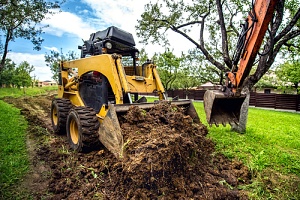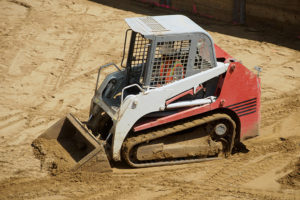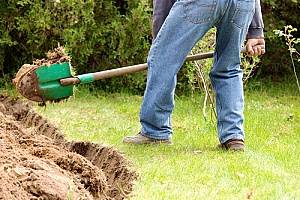When it comes to building a house, the old saying “a strong foundation is key” couldn’t be more accurate. But have you ever considered that this foundation extends beyond just the concrete slab upon which your home stands? Proper land grading is an often-overlooked yet crucial aspect of ensuring your home’s stability, functionality, and longevity. In this article, we’ll delve into the world of grading and its significance in safeguarding your home from water damage, soil erosion, and other potential issues.
Understanding the Basics
 First things first, let’s clarify what grading means in the context of home construction. Grading refers to the manipulation of the land’s surface to achieve a desired slope and contour. This process plays a pivotal role in preventing water from infiltrating your home’s foundation and in preventing soil erosion. Grading isn’t just about aesthetics; it’s about creating an environment that protects your investment.
First things first, let’s clarify what grading means in the context of home construction. Grading refers to the manipulation of the land’s surface to achieve a desired slope and contour. This process plays a pivotal role in preventing water from infiltrating your home’s foundation and in preventing soil erosion. Grading isn’t just about aesthetics; it’s about creating an environment that protects your investment.
The Significance of Proper Grading
Proper grading isn’t just about keeping your landscaping looking pristine – it’s a fundamental line of defense against a variety of potential problems. If your property isn’t graded correctly, water can easily pool around your foundation, leading to hydrostatic pressure that can weaken your foundation walls and cause leaks into your basement. Additionally, improper grading can result in soil erosion, compromising the structural integrity of your property and potentially causing damage to your foundation.
Steps to Achieve Effective Grading
 To ensure a successful implementation of effective grading, it’s crucial to adopt a well-structured and thoughtful approach that takes into consideration both the practical and aesthetic aspects of the landscape. The journey towards achieving optimal grading involves a series of strategic steps that culminate in a harmonious and functional outdoor environment.
To ensure a successful implementation of effective grading, it’s crucial to adopt a well-structured and thoughtful approach that takes into consideration both the practical and aesthetic aspects of the landscape. The journey towards achieving optimal grading involves a series of strategic steps that culminate in a harmonious and functional outdoor environment.
Comprehensive Site Analysis and Assessment
Embark on your grading journey by conducting a comprehensive site analysis. This involves a meticulous examination of the topography, soil composition, and existing vegetation on your property. By gaining a deep understanding of these factors, you can identify potential challenges and opportunities that will guide your grading decisions. Furthermore, a thorough assessment helps you pinpoint areas prone to erosion, flooding, or inadequate drainage.
Sensitivity to Natural Slopes and Risks
 As you delve into the grading process, it’s essential to embrace the natural contours of your property. These natural slopes play a critical role in directing water flow and influencing the overall landscape aesthetics. While identifying these slopes, also pay attention to areas that might pose risks, such as places where water accumulation could damage structures or erode soil. By acknowledging these factors, you can tailor your grading strategy to mitigate potential issues.
As you delve into the grading process, it’s essential to embrace the natural contours of your property. These natural slopes play a critical role in directing water flow and influencing the overall landscape aesthetics. While identifying these slopes, also pay attention to areas that might pose risks, such as places where water accumulation could damage structures or erode soil. By acknowledging these factors, you can tailor your grading strategy to mitigate potential issues.
Strategic Drainage Planning
A key aspect of effective grading is the formulation of a robust drainage plan. This plan should outline how water will be managed across your landscape, ensuring that it flows away from structures and vulnerable areas. Incorporating elements such as swales, French drains, and catch basins can help redirect and manage water effectively, preventing erosion and flooding.
Crafting a Thoughtful Grading Strategy
With the insights from your site analysis and drainage plan, it’s time to craft a grading strategy that aligns with your property’s unique characteristics. This involves making decisions on how to grade different sections of the landscape, creating gentle slopes that guide water away from your foundation. By skillfully contouring the land, you can also enhance the visual appeal of your outdoor space.
Intelligent Material Selection:
 Choosing the right materials is a pivotal aspect of effective grading. Incorporating gravel in strategic areas aids in facilitating proper drainage, preventing water from pooling and causing damage. Additionally, integrating appropriate vegetation can stabilize soil and reduce erosion, contributing to the overall health of your landscape.
Choosing the right materials is a pivotal aspect of effective grading. Incorporating gravel in strategic areas aids in facilitating proper drainage, preventing water from pooling and causing damage. Additionally, integrating appropriate vegetation can stabilize soil and reduce erosion, contributing to the overall health of your landscape.
Integration of Retaining Walls and Terracing:
For properties with varying elevations, the inclusion of retaining walls and terracing can be transformative. These features not only add visual interest but also serve practical purposes. Retaining walls hold back soil, preventing erosion and allowing for distinct levels within your landscape. Terracing, on the other hand, creates usable flat spaces on steep slopes, enhancing accessibility and functionality.
Implementing Grading Techniques
Drainage is a key player in effective grading. Install French drains and gutter systems to direct water away from your home’s foundation, preventing moisture-related issues. Create swales and berms to control water flow and minimize erosion. If your property has varying levels, consider retaining walls and terracing to manage the slope and create functional, beautiful spaces.
Seeking Professional Help
While DIY can be rewarding, grading is an area where professional expertise is invaluable. Consult with experts when faced with complex grading scenarios or legal and safety considerations. Finding a qualified contractor involves research, recommendations, and thorough background checks to ensure you’re entrusting your home to capable hands.
Maintenance and Long-Term Care
Effective grading isn’t a “set it and forget it” affair. Regular inspections and maintenance are vital. Look for signs of erosion or shifting soil and keep drainage systems clear of debris. Additionally, be prepared to adapt your grading strategy to changes in landscaping or extreme weather events.
Reach out to the Northern Virginia Land Grading Experts
Proper grading isn’t just an optional extra when building or renovating your home – it’s a cornerstone of a solid foundation. By understanding the basics, implementing effective techniques, and seeking professional guidance when needed, you’re investing in the long-term stability and functionality of your home.
Professional dirt grading assistance is always recommended to ensure that your property can thrive, whether it’s yet to be built, or currently standing. The tips for grading and foundation work for residential construction, will help you get the job done right.
Grading often requires fill dirt for creating the right sloping that prevents water damage. If you need reliable, free dirt delivery, professional residential dirt grading assistance, and site work, get in contact with Dirt Connections today by giving us a call or sending a message online. We have the knowledge and experience to provide your property and your projects with what they need.












































